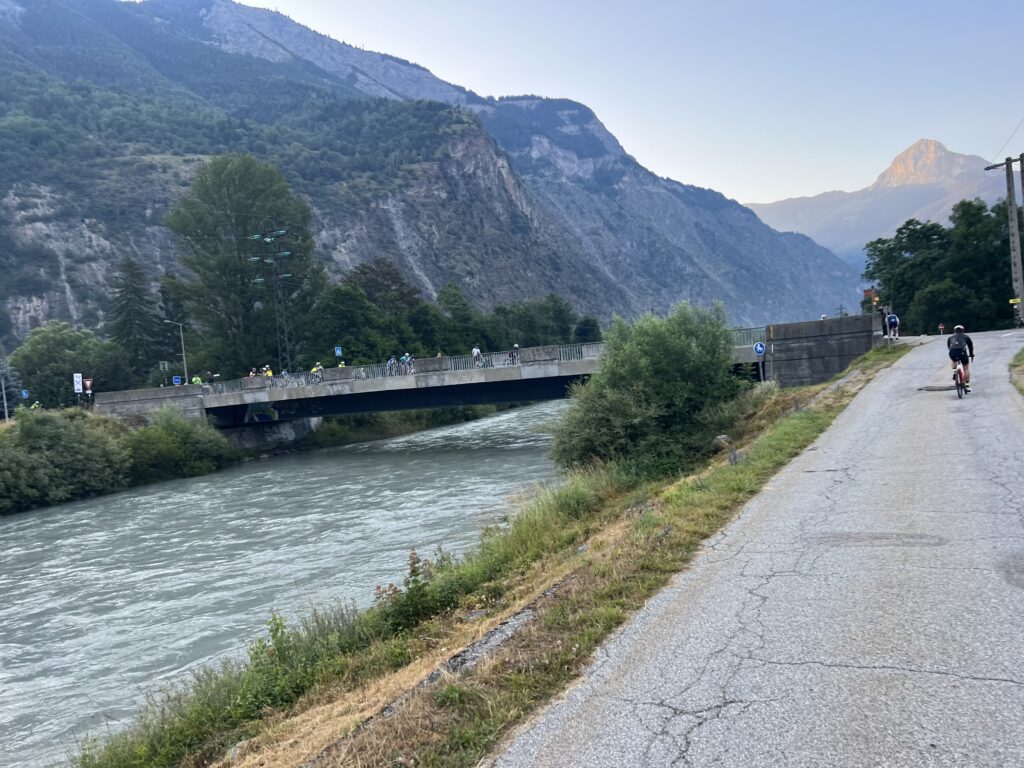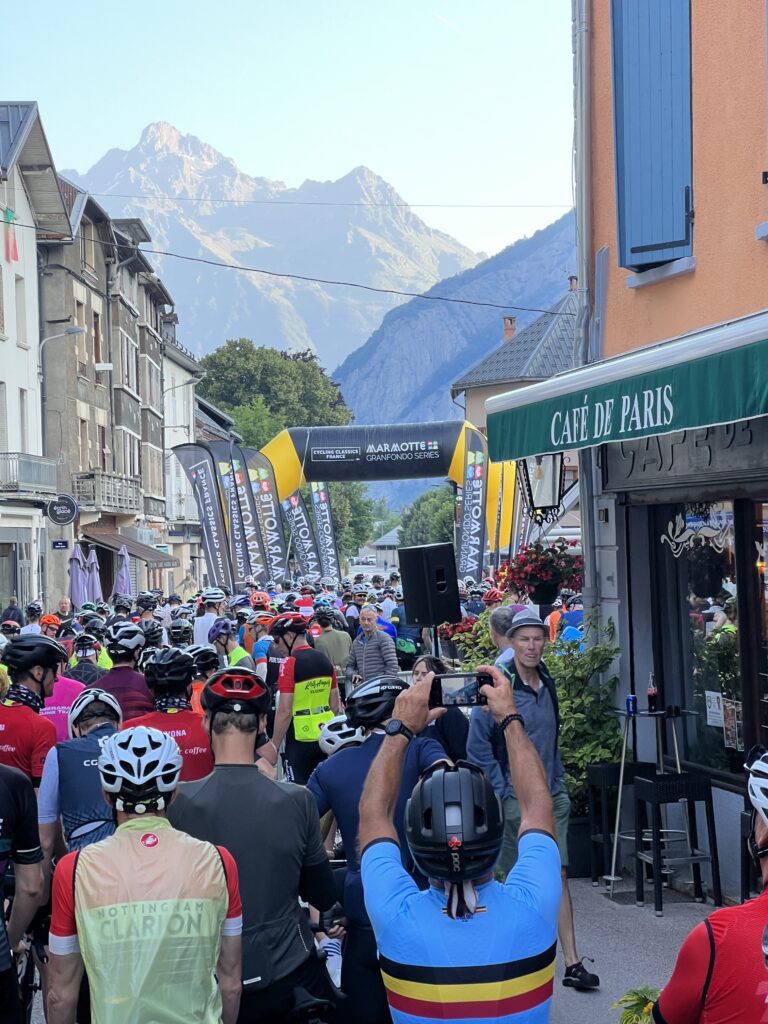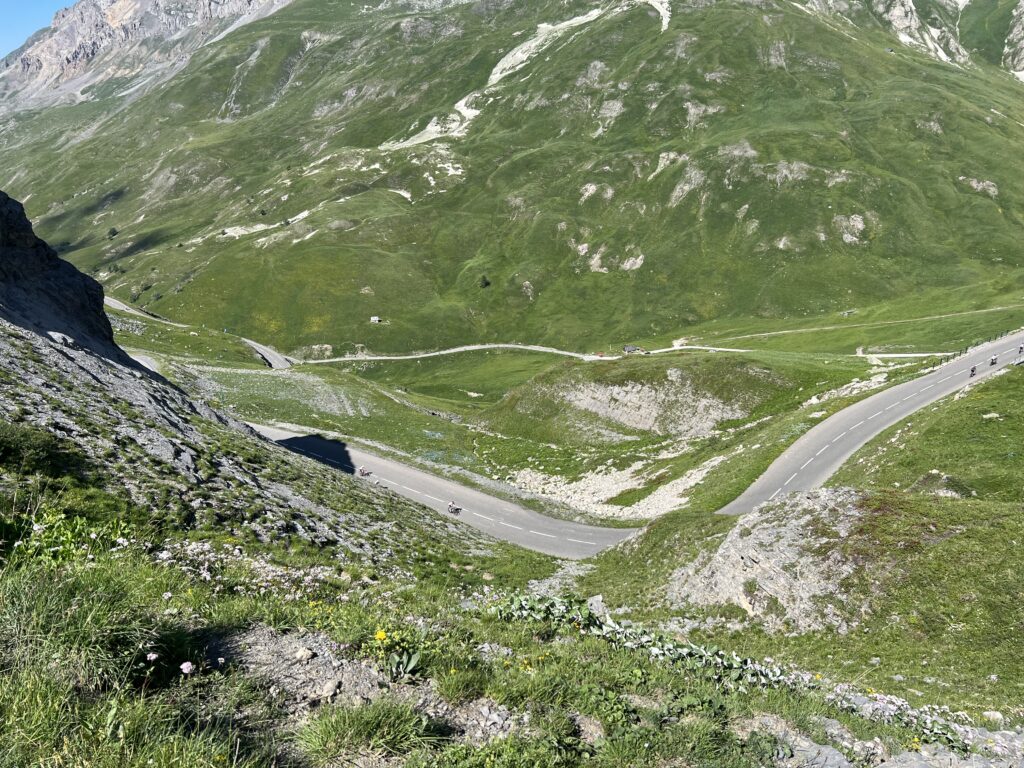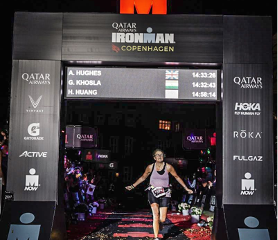Introduction
Marmotte (French). A small cute cuddly alpine animal, also a large brutal annual alpine bike ride. The Marmotte ride, the cyclosportive has been around since 1982 making it one of the oldest events of its kind. Each year many more entrants apply than the 7000 who are successful in getting a place.
The route varies slightly each year depending on local factors. It always starts in the town of Bourg D’Oisans, and finishes at the top of Alpe D’Huez though. Inbetween it takes in other major alpine climbs, normally Col de Glandon, Col de Telegraph and Col de Galibier, before the final ascent of Alpe D’Huez. Its 175km long with 5000+ vertical metres of climbing. A big day out in anyones book. Certainly not something to take lightly without adequate preparation, that would be foolish in the extreme.
We’ve been here before
I first took on the Marmotte ride back in 2013. At the time I was relatively inexperienced, having only ridden one other hilly sportive. The Fred Whitton Challenge in the Lake District was a tough ride earlier that year. See club member Ben’s excellent and entertaining write up of his experience of the Fred.
It’s a bucket list ride every cyclist should do once, but probably won’t want to do twice. “Fred Whitton Made Me Cry”, would be the headline for my write up. I did do the Fred again a few years later when I was much fitter, lighter, and better experienced. Lighter and fitter is a great strategy when revisiting a major mountain event. Definitely a strategy I should have followed for the Marmotte ride.
Back in 2013 I finished the Marmotte ride, but not officially, due to various challenges on the ride. Would I do better 10 years later?
I hadn’t planned to do the Marmotte ride a decade on. I’d originally signed up to do the 2020 ride, but Covid happened. It got delayed to 2021, then 2022 until finally in 2023 I rolled my original entry over to do it.
Preparation for the Marmotte ride
This will be a short section. I didn’t do much prep. Post covid I wasn’t commuting to the office and life had got in the way of my regular cycling. I took a lovely few days in Mallorca with my wife. This and 5 days of climbs on our club trip (see here for Iains write up) was my main training. I did the big rides in the Dolomites but always as a straggler, struggling up the long climbs. It wasn’t anywhere near enough training, but I had a cunning plan that couldn’t fail.
The Marmotte ride 2023 Climbs and a last minute shock
I’d expected Marmotte ride 2023 to follow the usual route over 4 classic cols.
| Climb Name | Length | Total Ascent | Maximum Altitude |
| Col du Glandon | 26.6km | 1355m | 1927m |
| Col de Telegraph | 11.8km | 837m | 1566m |
| Col de Galibier | 17.5km | 1213m | 2642m |
| Alpe D’Huez | 13.9km | 1118m | 1840m |
I thought it might go over the Croix de Fer rather than the Glandon. This is an extra couple of kilometres and 200m more climbing, but is a better descent. The ride also avoids some of the slog up the Maurienne valley.
I’m a big lad, 6’3/190cm and quite heavy, varying somewhere between 90 and 100KG (sometimes slightly more than 100KG). I’m not exactly built for climbing mountains, but I am pretty quick at getting down them. That was my infallible plan, I’ll be slow on the uphills, but could make up time on the descents.
Two weeks before the event though, the organisers changed the route due to roadworks on the Glandon. They didn’t just send the route over the Croix de Fer, but added the Col du Mollard, leaving the 2023 route with the following climbs
| Climb Name | Length | Total Ascent | Maximum Altitude |
| Col de La Croix de Fer | 29.1km | 1494m | 2066m |
| Col du Mollard. | 6km | 404m | 1635m |
| Col de Telegraph | 11.8km | 837m | 1566m |
| Col de Galibier | 17.5km | 1213m | 2642m |
| Alpe D’Huez | 13.9km | 1118m | 1840m |
The extra ascent was bad enough, but compared to the relatively straight road off the Croix de Fer, the descent had 48 hairpin bends. My foolproof plan wasn’t looking so foolproof.

An Early Start for the Marmotte ride

I was cycling the Marmotte ride with my sister’s partner John. We’d both ridden it back in 2013, one of us did a slightly better job than the other back then too. John is a lot lighter than me, and had actually done some training, both of which were quite selfish of him. I didn’t expect to see much of him during the day, and I wasn’t wrong.

We left our base in Vaujany at 5:44am, and enjoyed the fabulous high speed descent to the valley, with only a few hairpins, and then the ride to the start in Bourg D’Oisans along the side of the Romanche river, surrounded by huge mountains that we’d have to ride over in a couple of hours.

The atmosphere was both exciting and tense, as everyone gathered in the town, fenced in with metal barriers and raring to get on the road. We were in one of the earlier pens, and started at 8am. A quick briefing at the start, some loud and inspirational music, then we were off along the valley floor.

After a few kilometres, we hit the start of the first climb with the zig zag ascent up the front of the dam to the Lac du Vernay. Part of an EDF pumped storage scheme with the Lac du Grand Maison as the upper lake. A few weeks later we’d be on a family holiday cruising around the Lac du Vernay on a Pedalo, today we had a lot more pedalling to do. Soon we hit the bottom of the Col du Glandon/ Col du Croix de Fer, the road leads to both cols (mountain passes).
Col de Croix de Fer
The climb to the Glandon and Croix de Fer starts in dense woods and passes through some scenic alpine villages. Sometime around 1989 part of the road was swept away by a landslide, so it had to be rerouted to the other side of the valley via a steep descent with (only) a couple of hairpins, and a short 20% uphill slope, where many riders end up stuck in a high gear and desperately trying to change down.
Parts of the old road are still visible if you look closely. The road descends again down to the beautiful Lac du Grand Maison, with its unusual mountain huts, where you can often hear, and sometimes see, Marmottes on the side of the mountain.
Col de Glandon
The road then climbs again above the treeline, past the turn off for the Col de Glandon to the rocky summit of the Croix de Fer, and for the Marmotte, the first feed station.
I’d planned to fuel up at the feed station, but it was chaos and very hard to get anywhere near the food. I filled my water bottles and decided to make some time up. The road off the top of the Croix de Fer is very narrow, and most people were wisely taking it easy it being the first major descent of the day.
Planning to make some time up, I grabbed the drops, got some speed up and sailed past the queue of slower riders, only to be confronted by a convoy of motorbikes and cars heading straight for me. It was the last thing I was expecting, despite the number of riders, the roads aren’t closed to vehicles. I couldn’t go right as there was a queue of riders there so I dived elegantly and expertly into the rocky ditch on the left, completely maintaining my dignity and not looking at all stupid or reckless.
Early exit (and possible death) averted, I proceeded slowly and carefully down the hill, overtaking a lot of people being even slower and carefuller, and stopping only to borrow an allen key to tighten my water bottle holder that had inexplicably come loose. The rest of the descent was great fun, long sweeping turns and top quality tarmac.
Marmotte ride bonus climb and bogus descent. Col du Mollard
The Col du Mollard is only 6km long, but it is 6km uphill. It was pleasant enough, and over without any more drama. Time for another descent. I like descending, but this was ridiculously technical. The road surface wasn’t very good, it was largely in shade with patches of light through the trees making it almost impossible to tell what surface you were riding on, whether it was tarmac or loose gravel, and it was very busy with riders. Then the 48 hairpins, more than twice as many as Alpe D’Huez which is world famous and only has 21, the Mollard descent packs as many hairpins as the 24km Stelvio Pass into less than 10km.
I was just starting to enjoy the challenge when I saw the first ambulance. A rider prone on a stretcher in the back, covered in blood and in a bad way. There was a lot of blood on the road too.
I don’t know why the organisers chose to add the Mollard, instead of going down the more usual Croix de Fer descent, to St Jean du Maurienne. It was far too dangerous, and a bad decision, I hope those that crashed recovered OK.
There was one more ambulance on the way down, and then the relative safety of the Maurienne valley.
Hot Stuff. The Valley and Col de Telegraph
It was past midday now, 100km ridden (including to the start from Vaujany) and the temperature was rising above 40°c, there were a few places to fill bottles but long queues at all of them, causing more delays. I lost count of the number of times I filled my water bottles over the day, but I think it was about 30 bottles, some of which I just poured straight over my head.
I don’t remember much about climbing the Telegraph, it took a long time, 1 hour and 40 minutes and I was starting to struggle a bit. There’s another feed station after the Telegraph, but it takes forever to get there. After the short descent into Valloire, theres a 2km climb with some quite steep sections before you get to refuel. Or not, as there was hardly any food left. A few savoury Tuc biscuits and very little else.
Didn’t bode well for the long climb up the Galibier. I ate what I could, and shoved a few into my back pocket where they mixed with sweat, forming an unpleasant gooey composite material that was unlikely to feature in the manufacture of bike frames.
The hell of the Galibier
Hungry, overheating and very tired, the Galibier was where my lack of fitness and training began to really hit home. I had to keep stopping to rest, and a lot of younger, lighter and fitter looking riders were in the same boat. Spotting two riders walking in their socks, carrying their shoes and wheeling their bikes, and they weren’t even halfway up was concerning. I asked if they planned on walking all the way and they just shrugged.
I sat on a rock and looked down at a dead Marmotte, which was both sad and appropriate. It took 2 ½ long hours to get to the top, and I missed the 16:15 cutoff by half an hour.

The descent off the Galibier is, apart from a couple of small sections, 40km downhill. It sounds like a great break after all the climbing, but by then every muscle aches and its really hard to be in the same position on the bike for such a long time. By now the Broom Wagons were circling to pick up riders who couldn’t go any further, there didn’t seem any point sitting in a coach for the long descent, listening to people complaining they’d worn their best cycling socks out, so I gunned it down the road as best I could.
On Alpine descents bikes are generally faster than cars, and certainly faster than coaches. I could either keep braking, or overtake the broom wagons. The drivers were helpful, making space to let me and other riders past. There are quite a few tunnels on the road down, and some spectacular scenery and I made a mental note to come back and see it. After what seemed forever I arrived at the bottom of Alpe D’Huez.
Missing Section 🙁
This should be where I talk about my amazing ascent of the Alpe, but it wasn’t and I didn’t, so I won’t. I was too late, so filled my bottles one last time and left the Marmotte ride behind.
The long (Marmotte) ride home
I still had the ride back to Vaujany to do, another 20km with a climb that’s hard enough on fresh legs, never mind legs that have had unreasonable demands made of them for the last 14 hours.
We could have left the hire van at the bottom of the hill, but the lure of that ride down in the morning had been too tempting. I enjoyed the ride along the valley floor, and didn’t enioy the climb, but an hour and 40 minutes later I was back in the chalet, and waiting for John who had made it up the Alpe and was on his way back. I wasn’t at all jealous or bitter.
he eventually made it back, we couldn’t eat anything but did manage a Grimbergen.

What do I take from the second Marmotte ride attempt
It’s always tempting to talk in “What Ifs” when you don’t quite achieve what you set out to do. Maybe if the route of the Marmotte ride hadn’t changed I’d have made the cutoff, but in reality those 48 hairpins only took 40 minutes or so to get down, so I wouldn’t have saved that much time. The road to Marmotte is littered with people who didn’t quite train hard enough. Will I try the Marmotte ride again? No. Definitely not.
Statistics
Total ride length 211.58km
Total ascent 4732m
Moving Time 12:52:26
Elapsed time 15:22:44
Total Calories Burned 7297
Travel and Accommodation
We flew to Lyon, rented a van from there and stayed in Vaujany in the wonderful Chalet Betelgeuse, highly recommended.



0 Comments